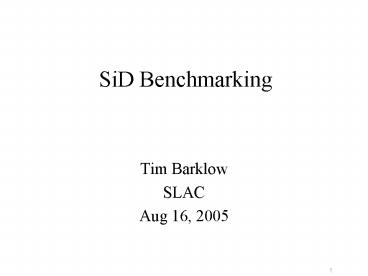SiD Benchmarking - PowerPoint PPT Presentation
1 / 12
Title:
SiD Benchmarking
Description:
To develop the Linear Collider detector studies with precise understanding of ... It emulates the bottom line performance of the event reconstruction software in ... – PowerPoint PPT presentation
Number of Views:60
Avg rating:3.0/5.0
Title: SiD Benchmarking
1
SiD Benchmarking
- Tim Barklow
- SLAC
- Aug 16, 2005
2
GOALSPhysics and Detector Workshop
- To develop the Linear Collider detector studies
with precise understanding of the technical
details and physics performance of candidate
detector concepts, as well as the required future
RD, test beam plans, machine-detector interface
and beamline instrumentation, cost estimates, and
other aspects.
3
Role of SiD Benchmarking Group
- An enormous amount of work has gone into the
development of the full GEANT4 simulation of the
SiD and the event reconstruction software. This
work has been and will continue to be the focus
of our effort to understand the physics
performance of the SiD. - Role of benchmarking group is simply to take
physics objects (electrons, muons, charged
hadrons, photons, neutral hadrons) produced by
the event reconstruction software and calculate
measurement errors for a variety of physics
processes using the SiD baseline and variants.
4
Detector Simulation
- Physics performance can only be correctly
evaluated using full GEANT4 MC simulation of
detector and optimized event reconstruction
software. - However, the full MC simulation and event reco
software is still under development. Physics
benchmarking studies can proceed in parallel with
this effort using a Fast Monte Carlo.
5
Detector Simulation
- In the context of SiD benchmarking the Fast Monte
Carlo should be considered a Fast Physics Object
Monte Carlo. It emulates the bottom line
performance of the event reconstruction software
in producing the electron, muon, charged hadron,
photon and neutral hadron physics objects. - SiD Fast MC status
- Tracker simulation uses parameterized covariance
matrices to smear momenta. Program by Bruce
Schumm is used to calculate covariance matrices
based on tracker geometry and material. Cov.
matrices have already been produced for SiD
baseline and 3 variants. - Electron and muon id given by min energy
overall efficiency - Photon and neutral hadron energies angles
smeared using single particle EM hadronic
energy angle resolutions. Photons and neutral
hadrons have a min energy and overall efficiency
within detector volume.
6
Detector Simulation
- Fast MC with nominal single particle calorimeter
response gives 17/sqrt(E) jet energy resolution.
This can be tuned to any value by varying the
single particle EM hadronic calorimeter energy
resolutions and by replacing charged particle
tracker momentum with calorimeter energy a
certain fraction of the time. - Will improve the parameterization of calorimeter
response as we learn more from the particle flow
algorithm studies.
7
Detector Simulation
- Envision 3 stages of physics benchmarks studies
- 1) Fast MC with parameterized tracker cov.
matrices and calorimeter response given by
overall jet energy resolution of n/sqrt(E) with
n30 50. - 2) Fast MC with parmeterized tracker cov.
matrices and calorimeter response given by
parameterized jet energy resolutions based on
full MC PFA studies of SiD baseline variants - 3) Full MC studies
8
Physics Benchmark Processes
9
Physics Benchmark Processes
Reduced Benchmark List
Only physics processes which have already been
extensively studied and for which established
analysis algorithms exist appear in the reduced
benchmark list.
10
Leveraging Existing Analyses
- Many physics analyses have already been developed
which utilize physics objects as input. The
analysis algorithms are relatively independent of
the details of the detector design. By sharing
such analysis algorithms among the concept groups
the existing physics analysis work can be
leveraged to provide a broad survey of detector
physics performance.
11
Tools at Snowmass
- MC Data sets (stdhep files) of all SM processes
at Ecm500 GeV assuming nominal ILC machine
parameters - About 50 fb-1 with e- pol/- 90 available at
- ftp//ftp-glast.slac.stanford.edu/glast.u32/simdet
_output/simd401xx/whizdata.stdhep (-90 e- pol) - ftp//ftp-glast.slac.stanford.edu/glast.u32/simdet
_output/simd402xx/whizdata.stdhep (90 e- pol) - 1 ab-1 on SLAC mass storage with all initial
e,e- polarization states - Many Monte Carlos (Pythia, Whizard) for producing
additional stdhep files - SiD Fast MC which takes stdhep files as input and
produces reconstructed LCIO objects as output - Your physics analysis based on reco LCIO objects
(there exist LCIO bindings for FORTRAN, C ,
JAVA )
12
Initial SiD Benchmark Meetings
- Short organizational meeting this afternoon in
this room following SiD plenary - Meet tomorrow, Wed Aug 17, 1030 1200 in
Jewellers Room, Silvertree Hotel































